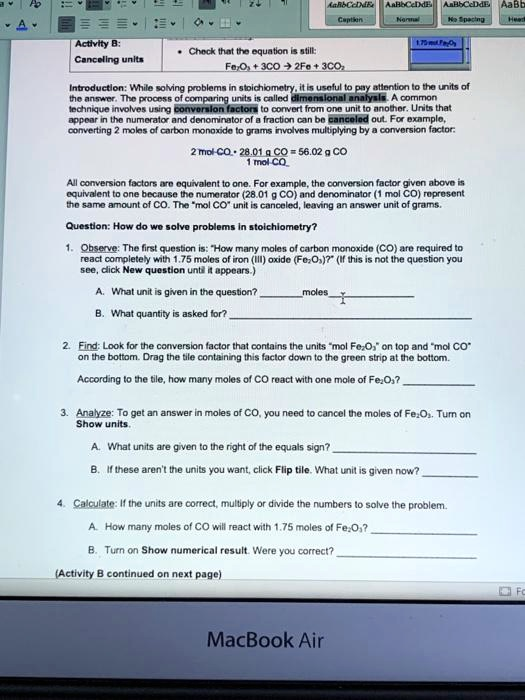Student Exploration: Stoichiometry Gizmo Activity B Check that the equation is still: FeO + 3CO2 -> Fe + 3CO Canceling units Introduction: While solving problems in stoichiometry, it is useful to pay attention to the units of the answer. The process of comparing units is called dimensional analysis. A common technique involves using conversion factors to convert from one unit to another. Units that appear in the numerator and denominator of a fraction can be canceled out. For example, converting 2 moles of carbon monoxide to grams involves multiplying by a conversion factor: 2 mol-CO * 28.01 g CO / 1 mol-CO = 56.02 g CO. All conversion factors are equivalent to one. For example, the conversion factor given above is equivalent to one because the numerator (28.01 g CO) and denominator (1 mol CO) represent the same amount of CO. The mol CO unit is canceled, leaving an answer unit of grams. Question: How do we solve problems in stoichiometry? 1. Observe: The first question is: How many moles of carbon monoxide (CO) are required to… (see, click New question until it appears.) A. What unit is given in the question? moles B. What quantity is asked for? 2. Find: Look for the conversion factor that contains the units mol FeO on top and mol CO on the bottom. Drag the tile containing this factor down to the green strip at the bottom. According to the tile, how many moles of CO react with one mole of FeO? 3. Analyze: To get an answer in moles of CO, you need to cancel the moles of FeO. Turn on Show units. A. What units are given to the right of the equals sign? B. If these aren’t the units you want, click Flip tile. What unit is given now? 4. Calculate: If the units are correct, multiply or divide the numbers to solve the problem. A. How many moles of CO will react with 1.75 moles of FeO? B. Turn on Show numerical result. Were you correct? Activity B continued on the next page

The Correct Answer and Explanation is:
Let’s work through the Gizmo Activity B step by step.
Given:
Balanced equation:
Fe₂O₃ + 3CO → 2Fe + 3CO₂
Step 1: Observe
Question:
“How many moles of carbon monoxide (CO) are required to react completely with 1.75 moles of iron (III) oxide (Fe₂O₃)?”
A. What unit is given in the question?
Moles Fe₂O₃
B. What quantity is asked for?
Moles of CO
Step 2: Find the Conversion Factor
From the balanced equation:
1 mol Fe₂O₃ reacts with 3 mol CO
So, the correct conversion factor is:
(3 mol CO) / (1 mol Fe₂O₃)
Step 3: Analyze
To solve the problem:
- Start with the given value: 1.75 mol Fe₂O₃
- Multiply by the conversion factor to cancel out “mol Fe₂O₃” and leave “mol CO”
A. What units are given to the right of the equals sign?
Initially: mol Fe₂O₃
B. After applying the conversion factor, the units become:
mol CO
Step 4: Calculate
Multiply: 1.75 mol Fe₂O₃×3 mol CO1 mol Fe₂O₃=5.25 mol CO1.75 \, \text{mol Fe₂O₃} \times \frac{3 \, \text{mol CO}}{1 \, \text{mol Fe₂O₃}} = 5.25 \, \text{mol CO}1.75mol Fe₂O₃×1mol Fe₂O₃3mol CO=5.25mol CO
A. How many moles of CO will react with 1.75 moles of Fe₂O₃?
Answer: 5.25 mol CO
B. Were you correct after checking Show numerical result?
Yes, 5.25 mol CO is the correct and expected answer.
Explanation
In stoichiometry, understanding how to convert between different substances in a chemical reaction is critical. This involves using the mole ratio from a balanced chemical equation. Dimensional analysis helps manage these unit conversions.
In this example, the balanced equation tells us that 1 mole of Fe₂O₃ reacts with 3 moles of CO. That gives us a ratio or conversion factor:
(3 mol CO) / (1 mol Fe₂O₃).
You start with what is given: 1.75 mol Fe₂O₃. To find how many moles of carbon monoxide are needed, multiply this amount by the conversion factor. This cancels out the unit “mol Fe₂O₃” and leaves “mol CO”. 1.75 mol Fe₂O₃×3 mol CO1 mol Fe₂O₃=5.25 mol CO1.75 \, \text{mol Fe₂O₃} \times \frac{3 \, \text{mol CO}}{1 \, \text{mol Fe₂O₃}} = 5.25 \, \text{mol CO}1.75mol Fe₂O₃×1mol Fe₂O₃3mol CO=5.25mol CO
This tells us that 5.25 moles of CO are required to react with 1.75 moles of Fe₂O₃. Unit cancellation helps ensure the correctness of your approach, and that you end up with the desired unit in the answer.
This method is useful for all stoichiometry problems, where quantities of reactants or products are calculated using mole ratios and conversion factors derived from balanced equations.
